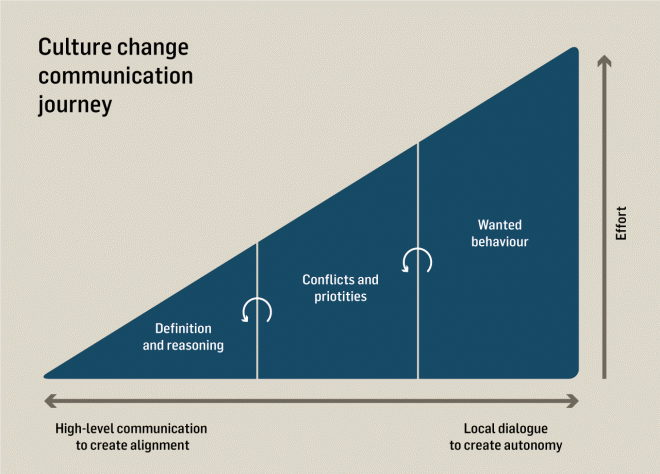Communication plays a key role in working with culture.
Whether you want to implement new values, strengthen or sustain existing culture or change the behaviour of your organisation, you need to communicate through dialogue.
In Workz we focus on three principles of communication when helping our clients change their culture:
- Focus on communicating why the culture is right for the organisation, and even more on engaging the organisation
- Acknowledge conflicting agendas and concerns, and help point the way to navigate the paradoxes
- Do not try to figure everything out at HQ, make room for local translation
Use these three approaches as the starting point for your culture change communication journey.
Communicate for engagement
Culture is what we do when nobody is watching. This links cultural changes closely to behavioural changes. It is rarely enough to have employees standing on the side-lines, nodding their heads in agreement while serving them information only. You need them on the field, playing the game, actively taking part by 'doing'.
To do this, you have to communicate on two vectors. On one hand you must convince everybody that the "new culture" you are working towards is valuable, beneficial and the right fit for the organisation and your current strategy. This is important, no doubt about it, but not as important as in other kinds of strategic communication. You must focus even more on making everybody actively contribute to the new culture.
In other words, it is not enough to create buy-in. You have to engage as well. Otherwise, you might end up with an organisation that believes in the new culture, but also that it is somebody else’s responsibility.
“Customer centricity? That belongs to Marketing”.
But how do you communicate to engage? Well, engagement can be seen as a combination of role and motivation.
Playing an active role means working with a clear set of expectations, a mandate and a sense of purpose. One of the biggest tasks of engaging storytelling is to frame your communication in a way that transforms the audience into the protagonist. If you do not carve out a clear role for them, you risk that they invent one for themselves. The role of "victim" or "innocent bystander" is often the result. This applies to all change projects, not just culture.
Motivating is also done by changing perspective and framing the communication in a different way. Not everybody is motivated by the company perspective that we often default to when explaining "the why". They might be better motivated by another source of motivation – ranging from themselves to the society at large. To many employees “Outperforming the competitors” is less motivating than “Become a better version of yourself” or “Bringing our treatments to more patients”.
As a rule of thumb, when it comes to culture, you should spend less effort on convincing people, and more on engaging them.
Bring shadow stories into the light
When working with new values or strengthening existing culture, we almost always deal in positive words and concepts. It is actually rare that the values in isolation are negatively received by the organisation, which makes it even more pointless to spend too much effort on "the why". The challenge is usually to make a convincing argument as to why they are better than other values at play.
The gut reaction in most cases is to view the organisation as a zero-sum game. Focusing on something reduces the importance of something else. Asking people to do A is interpreted as telling them to do less of B.
We call these untold narratives or conflicting agendas “shadow stories”. Addressing them explicitly is crucial. You must at least acknowledge that the conflicts exist or better even, provide a clear way to bypass the conflict OR help prioritise what is most important.
The slogan “Safety first” will sound hollow if we do not address how safety concerns relate to performance goals. Is it more important to be safe than to meet the daily quotas? Is it a matter of balanced concerns? Or do we propose that coexistence is possible by introducing a way forward? Maybe we can be safe and effective at the same time through technological investments or continuous improvement of the way we work.
One way or the other, you must bring the shadow stories into the light. Otherwise, these alternative narratives will not only keep pulling the organisation in the wrong direction – they will also undermine the trust in you as communicator.
“How can we believe what you say, if you clearly do not understand how our world works?”
To make matters worse, the conflicting agendas are often supported by organisational structures that also need to be addressed. Make sure that all measurements, incentives and ways of working support the new culture or the preferred prioritisation.
Communication can only point the way.
Make room for local translation
At this point you might be daunted by the work ahead. How do we target our communication to all parts of the organisation? How do we map and describe the roles, conflicts and wanted behaviour of every function?
Luckily our final advice is that you should let each part of the organisation do the heavy lifting themselves.
Trying to figure everything out from HQ is not only an enormous task but also a bad idea. It is impossible to get everything right – and every single wrong note risks destroying the overall messaging.
On the other hand, having each unit or function translate the values into local behaviour themselves is the most powerful tactic in the toolbox. It distributes workload, makes the translation more effective and creates buy-in and commitment at the level where it is most valuable.
Studies have shown that people attribute more financial value to a piece of IKEA furniture they have spent time putting together themselves than if somebody else did the building. Building it with somebody else makes this even more powerful.
When your team has created their own definitions, mapped their own conflicts, set their own priorities and agreed on a set of wanted behaviours, they will be far more likely to actually do it – and keep each other accountable along the way.
Done the right way, a local dialogue therefore helps with the two other tasks; it helps motivate and activate the employees while letting them bring their own shadow stories into the light.
Adding a feedback element to these dialogues makes it possible to loop back to the high-level organisational-wide value communication and make it even more relevant and effective.

A communication plan could look like this:
First, explaining why the values have been chosen, and are more important than others. The focus on getting the high-level definitions of the values in place making sure to acknowledge obvious conflicting agendas or paradoxes. Then communicate the roles and mandates of the employees and management and start the dialogue process that will lead into not only local commitment to behaviour, but also a more fine-tuned mapping of conflicts and need for prioritisation from top-management.
Ideally, the dialogue should never stop. In an ever changing world (new contexts, new employees, new strategies), the most resilient cultures are those that are able to constantly reinterpret themselves.
But communication is only where it starts. If you are hungry for more, check out this related article on leadership actions and their impact on changing organisational culture.


